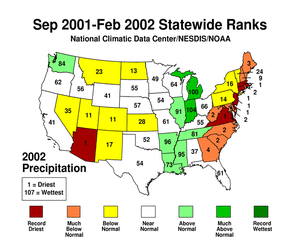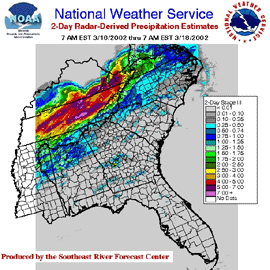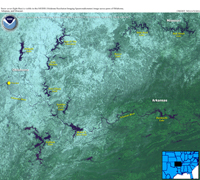 

|
 larger image |
Drought has intensified in parts of the eastern United States during the September 2001 - February 2002 period. Precipitation was associated with the main storm track which was from the south central states across the Mississippi and western Ohio Valleys and then across the central Great Lakes. States in those areas had average or above average precipitation. In contrast, areas to the east of that region, along the east coast, were very dry with drought intensifying. Note the difference in rankings between North Carolina and Tennessee.
|
| The difference in rankings shown above across Tennessee and North Carolina is also apparent on the March 16-18th, 2002 accumulated radar precipitation map. Areas in east central Tennessee picked up over 7.00 inches of rain while the majority of North Carolina outside of the mountains saw less than one-half of an inch of precipitation. |  larger image larger image |
| An analysis of the event was also done using National Weather Service, cooperative station data and GLOBE schools in and near the region that received flooding rains. In this analysis note how the GLOBE student data compares favorably with the rest of the analysis. Also, note the axis of the precipitation was across eastern Tennessee into southwestern Virginia. Note the difference in precipitation amounts between Knoxville, TN and Asheville, NC. |  larger image larger image |
See the following data summary for details on these storms.....
Rainfall Event, Mid March 2002
A massive sandstorm has enveloped most of northern China, covering the capital Beijing in a shroud of dense dust and reducing visibility to less than 50 meters in some areas. The storm is the strongest and most intense this spring, the official state-run Xinhua news agency reported, and hit China's north on the 19th with fierce winds. Sandstorms are frequent in spring, triggered by sudden seasonal temperature changes, Xinhua news agency reported. Sand is picked up from the expanding desert regions in northwestern China and Inner Mongolia. Dust storms choke northern China nearly every spring, often blown off the dry expanses of the Mongolian desert plain. But the problem has grown worse in the past 20 years because of deforestation and the increased drought across the north. The dust can be seen east of Beijing over the Yellow sea and the Sea of Japan.
Weather Log - March 21-31th, 2002
Flooding and landslides triggered by heavy rains have left 13 people dead and more than 6,000 people homeless throughout Ecuador. Torrential storms have drenched Ecuador for the past two weeks, causing rivers to overflow and flooding entire neighborhoods of towns and cities. Damage was worst in the coastal provinces of Manabi, El Oro and Guayas, where the country's second largest city, Guayaquil, is located. This type of event usually occurrs when water temperatures rise off the western South American coast and could possibly signal the return of El-Nino. See related story above.
Note: Hazard event satellite images available courtesy of NOAA OSEI Satellite Images WWW site.

 Selected U.S. City and State Extremes
Selected U.S. City and State Extremes
The Selected U.S. City and State Extremes provides a list of new records that were set across the U.S. during March 2002.

 Additional Resources
Additional Resources
- Recent Global Daily Data
- NOAA 2002 Hurricane Season Forecast
- National Fire News
- NOAA Fire Weather Information Center
- Midwest Climate Watch
- Southeast Climate Watch
- Northeast Climate Watch
- Southern Climate Watch
- NCDC El Nino / La Nina
- U.N. Relief Web- Natural Diisasters
- NNDC Climate Data Online (for long-term climate data)
- NCDC Climatic Extremes and Weather Events
- Tracking Drought-National Drought Mitigation Center (CNN-News Report)
- Additional NOAA OSEI Satellite Images(Western Fires, Tropical Storms, etc)
- NCDC Storm Event Database
- Links to Numerous Natural Disaster Web Sites
Downloaded Sunday, 21-Sep-2008 08:17:04 EDT
Last Updated Friday, 09-Nov-2007 16:00:19 EST by Tom.Ross@noaa.gov, Neal.Lott@noaa.gov, Axel.Graumann@noaa.gov, Sam.McCown@noaa.gov
Please see the NCDC Contact Page if you have questions or comments.





